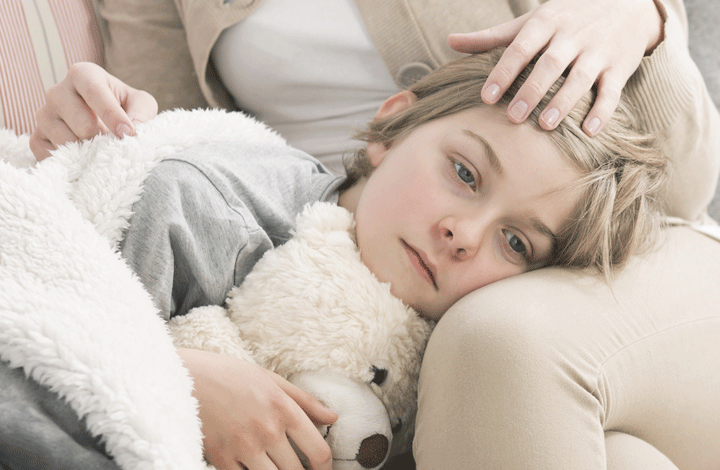Returning to Youth Sports after COVID
March 09, 2021

Fourteen-year-old Daymeion Marshmon is eager to return to school sports, which he hasn’t played since he had a mild bout of COVID-19 around the holidays. But that will have to wait until his lungs and heart recover from the after-effects of the virus.
Young athletes who had COVID-19 should seek medical clearance to rule out heart damage before returning to competitive sports, according to new American Academy of Pediatrics guidelines followed by pediatrics specialists at St. Luke’s University Health Network.
Chair of Pediatrics Jennifer Janco, MD, says a dangerous inflammatory condition of the heart, called myocarditis, can sometimes be caused by COVID, though it’s rare. The American Academy of Pediatrics advice comes from an “abundance of caution,” she says, adding that doctors at SLUHN so far have treated only a few youngsters who had symptoms that could signal that the heart muscle was impacted by the coronavirus.
Dr. Janco says the December 2020 guidance from the American Academy of Pediatrics suggests kids who had COVID with mild or no symptoms over less than four days, should at a minimum, discuss their recent health history with their primary care physician prior to starting sports competition.
“Their doctor will perform a physical exam, checking things such as blood pressure, heart rate and assessing for heart murmurs. She’ll also ask how they’ve been feeling and if they have had symptoms such as chest pain, dizziness, a racing heart or just not feeling right doing daily activities,” says Dr. Janco. “If the answer is no and their exam is normal, they’ll likely be told they’re fine to compete.”
Daymeion’s twin brother, Dayvion, was sick with COVID at the same time as his twin and had more serious symptoms for more than four days including the loss of smell and taste. However, Dayvion didn’t experience heart or breathing problems when he returned to the gym.
If pre-teens and teens have more moderate-to-severe symptoms for four days or longer, or were hospitalized for COVID, they might need to see a pediatric cardiologist for more tests and possibly abstain from competition longer for recuperation, say the guidelines. At a time when the medical community is still learning about the long- and short-term effects of the virus, in adults and kids, the information can change often.
Daymeion and Dayvion’s mother, Danielle Demesyeux, a nurse at St. Luke’s, took Daymeion to the ER when he had a tight chest, racing heart and breathing difficulties during a workout. Heart and blood tests, and a chest x-ray done there all came back normal. His pediatrician next referred him to Pediatric Cardiologist Elizabeth Adams, DO, who ordered more tests for him, including wearing a walking heart monitor for five days, which also was normal. Meanwhile, Daymeion continued having labored breathing and a racing heartbeat without exertion.
Mark McGill, MD, St. Luke’s Pediatric Cardiologist, says the American Academy of Pediatrics guidelines address “a grey area” of this virus, adding, “There’s a lot we don’t know yet about the effects of COVID on the heart, though some viruses, including COVID, can damage the heart if they enter it.”
He hasn’t treated many children for myocarditis caused by the virus so far and says the recommended approach of speaking with the patient and parents about recent symptoms first is likely the best initial avenue if the COVID case was mild or asymptomatic and there aren’t any lingering signs of illness within a few weeks of virus onset. He may order a test or series of them if symptoms persist or arise with exertion, but even they might not give a definite diagnosis, Dr. McGill adds, as the science at this point is somewhat inconclusive but continues to evolve. But, he says, the child’s safety is paramount above all else.
“We doctors are conservative and we don’t want to miss anything, so we might order an MRI, exercise test or Holter monitor,” Dr. McGill adds, “but a discussion is the best place to start. That’s the ‘art’ side of medicine.”
Daymeion’s appointment with a pulmonologist recently revealed that he’s recovering from Post-Acute COVID Syndrome, says his mother, and he’s slowly returning to activity as his heart and lungs heal.
“I will continue monitoring his breathing and gradually have him return to exercising at home,” Danielle says. He’ll have to sit out the spring sports season to rest, while his twin brother, Dayvion, who had no lingering COVID symptoms or sequelae, has restarted working out with no breathing or heart issues.
When the twins return to school sports, they’ll be in good hands. St. Luke’s athletic trainers have been working closely with the local school districts, parents and experts in pediatrics, cardiology and primary care sports medicine to identify and ensure student-athletes are safely returned to sports, says John Hauth, Senior Network Administrator, Sports Medicine Relations.
“Our Team worked collaboratively to develop and implement a COVID-19 Return to Play Protocol consistent with the current evidence,” he explains. “We are working closely with our colleagues to educate our partners about the need to carefully return student athletes to sport after a COVID-19 infection.”
Read More NewsLatest News

October 31, 2024
SLUHN Surgeon Recognized among Top-Cited Scientists

October 30, 2024
New Multispecialty Medical Office Building on Walbert Ave

October 30, 2024
Adoptee Seeks Reassurance Through DNA Answers Study

October 25, 2024